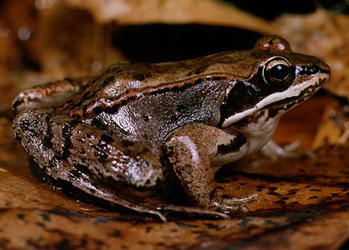
Molecular techniques such as microsatellite analysis make it possible to identify individual organisms and infer relatedness. We used these techniques to evaluate the importance of kin level structure and variation on the population ecology of wood frog, Rana sylvatica, in the wild. Wood frogs are ideal organisms in which to conduct this research because of the discrete nature of the breeding ponds and larval habitat, the relatively brief generation time, and the fact that many influential studies in population and community ecology have already been conducted on these and similar pond-breeding amphibians. This project was in collaboration with David Skelly (Yale Forestry School) and his group.
Publications:
Halverson, M.A., D.K. Skelly, and A. CACCONE. 2006. Inbreeding linked to amphibian survival in the wild but not in the laboratory. J. of Heredity 97: 499-507.
Halverson, M.A., D.K. Skelly, and A. CACCONE. 2006. Kin Distribution among wood frog (Rana sylvatica) larvae in the wild. Molecular Ecology 15: 1139-1146.